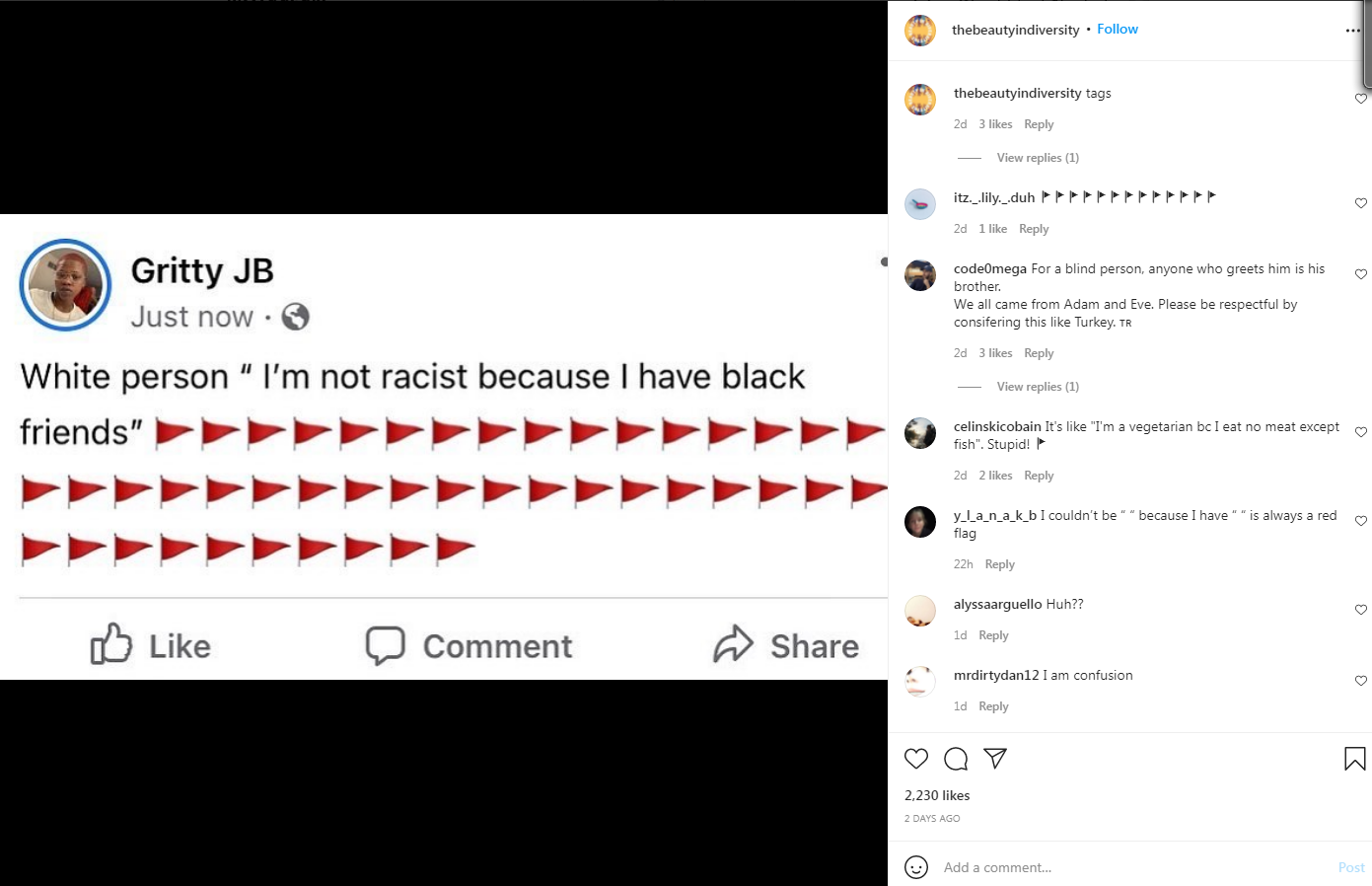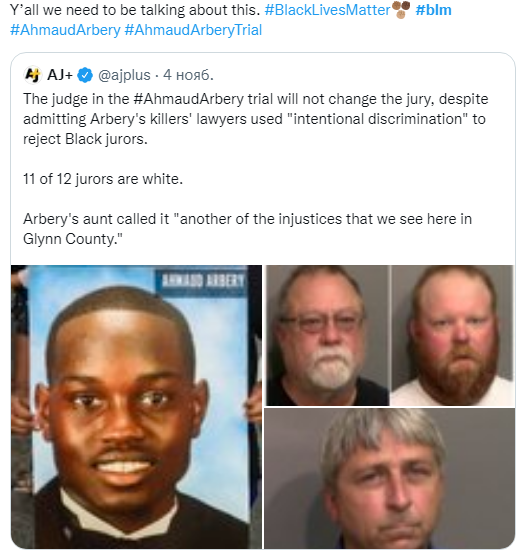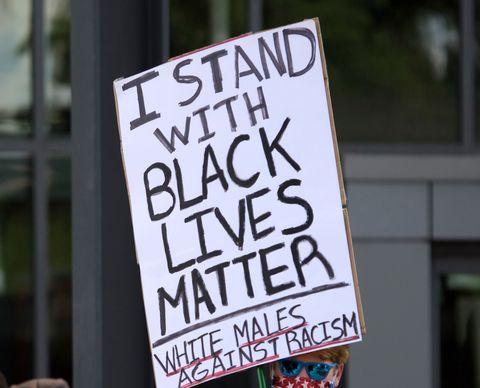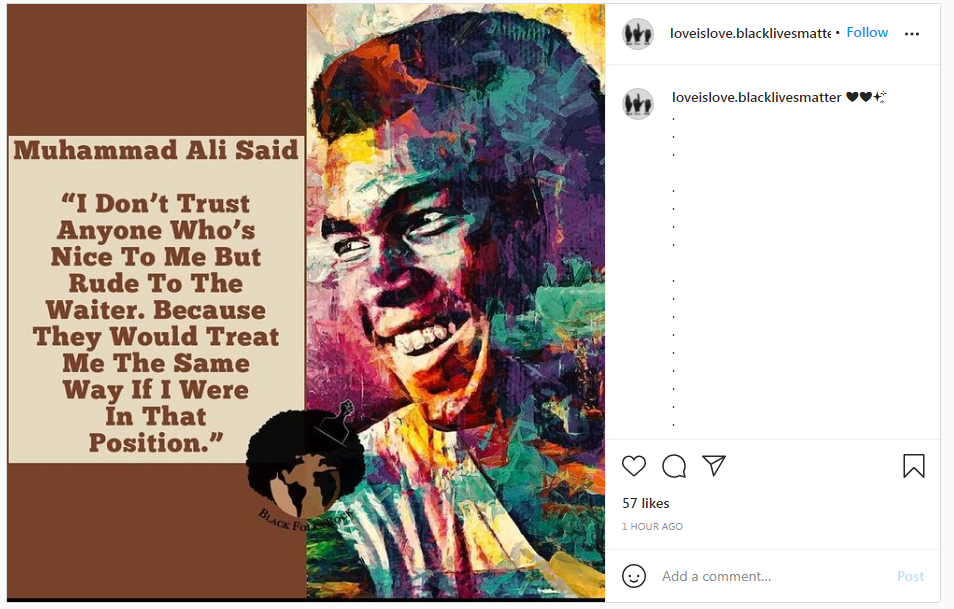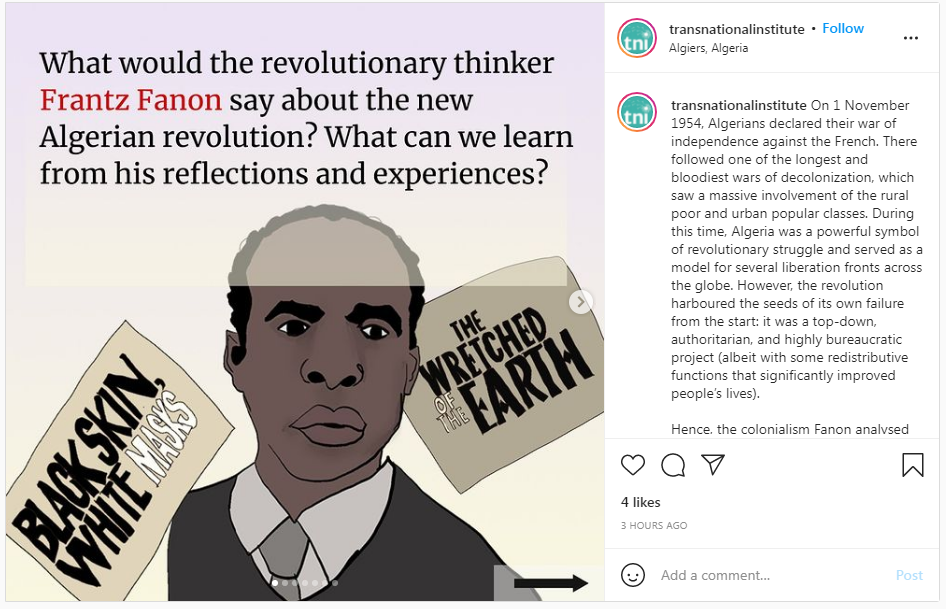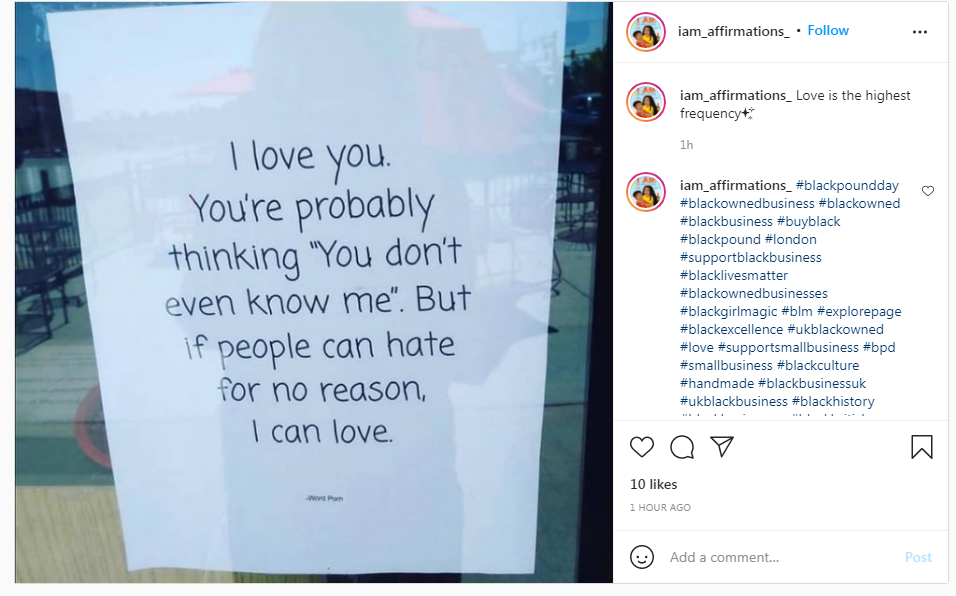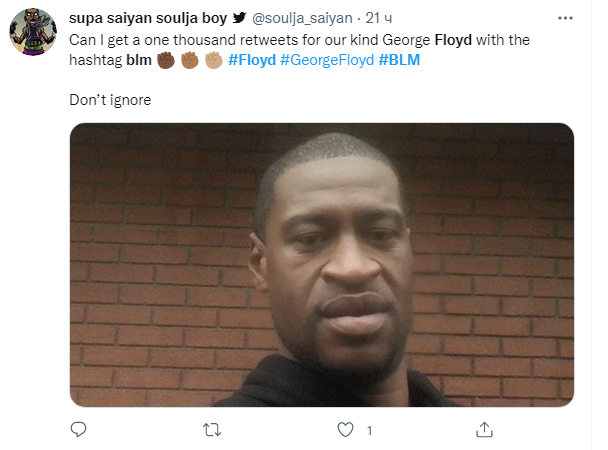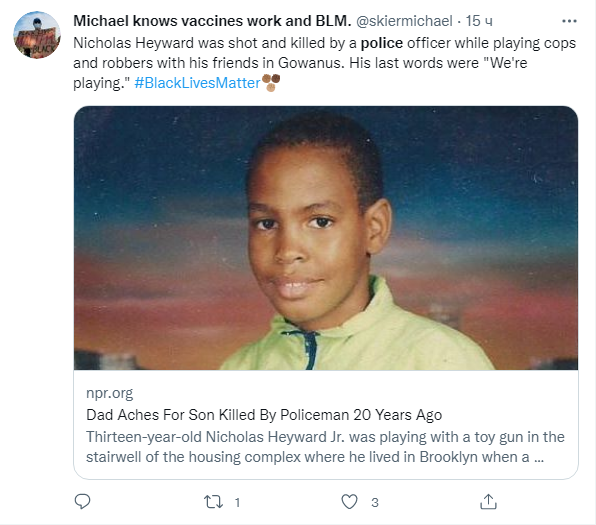The idea of social media participation as a form of political and social activism might have been taken with a grain of salt before. Nevertheless, with the rise of the impact that social networks have had on the promotion of social concerns, the specified form of supporting political and social movements has gained quite a significant traction. The multiple signs and other types of visuals created on social media networks such as Twitter and Instagram prove the role that the specified platforms have had in building social awareness. Varying wildly in range, genre, and means of expression, the signs created on social media in support of BLM range from straightforward plight to a subtle metaphor, exemplifying the dimensions of the U.S. political culture.
The range of images created to support the BLM movement on Twitter and Instagram has been staggering. These include inspirational posters (Fig. 4), appeals to justice (Fig. 5), and plight for equality (Fig. 6). Showing the power of unity and exemplifying the importance of social support, the images shared by Twitter and Instagram users have been quite versatile, both in the type of medium used and the expression methods. Among the most common signs, posters with captions reading “BLM,” “Black lives matter,” or similar supportive sentiments have been prevalent on Twitter and Instagram. However, in addition to the specified signs, other creative opportunities have been explored (Mundt 2). Remarkably, Instagram has shown even greater diversity of signs used to support the BLM movement, ranging from traditional written messages to pictures to memes and short videos.
Understandably, the main message that each of the signs with the #BLM hashtag promoted the need to protect the lives of African American people from racism, particularly from police brutality. Indeed, discrimination of African Americans by law enforcement has become a sad part of American reality (Spratt 87). However, some of the signs contained other implied ideas apart from the unwavering support of the BLM movement. For instance, the Instagram features quite a range of screenshots from Twitter posts, thus, creating a loop of BLM messages circulating the social media realm (see Fig. 1). The use of imagery allwos making teh message more articulate by providing a clear visual shorthand (Berger 14) Therefore, while the range of expression tools is restricted to digital ones, the proponents of the BLM movement have managed to integrate traditional art into creating signs that serve to support the BLM movement.
Fig. 2 also demonstrates the wide variety of approaches toward creating supportive signs as the means of encouraging the further progress of the BLM movement. Specifically, the original post features sarcasm, and bitter irony, whereas the commentaries range from sincere to ironic. The response that the specified sign has prompted indicates that the use of social media in furthering a social agenda, such as the need to protect African American people, is undeniably important.
Moreover, the images that Twitter and Instagram provide under the hashtag #BLM exemplify the different dimensions of the U.S. political culture. Since the supporters of the BLM movement come from a variety of backgrounds, they represent their message of supporting African American people in different ways. In addition, apart from positive messages, the specified social media also contain a plethora of content that could be described as politically diverse. For example, apart from attacking police brutality as the main focus of the movement, the sigs displayed to support African American people also capture protests against a range of other socially misconstrued ideas. For instance, a lot of the signs displayed on Twitter and Instagram show that the people producing them are against racism in general (see Fig. 2). Although the described approach can be defined as supportive, it also invites the discussion of other racism-related challenges that African American people face. Although the specified sentiment is understandable, it is also vital to keep the focus on the core idea of the movement.
Apart from racism, the signs created in support of African American people also condemn the concepts of police brutality and white nationalism. The specified stance is quite understandable to take given the fact that the movement representing the support of African American people still pursues the support of the force that overwhelmingly represent racist ideas and tends to sect African American people as a potential victim. Indeed, the infamous case of George Floyd proves that there are significant racism biases within the American police force, causing officers to use force selectively and target primarily African American people. The support of anti-racist ideas is expressed in the slogans written on the signs (Edrington and LaShara 289). Likewise, white nationalism is condemned wholeheartedly by the supporters of the BLM movement, which can be seen in their choice of signs.
However, remarkably, the specified phenomenon is rarely named directly; instead, BLM supporters tend to focus on the idea of supporting African Americans as opposed to fighting against white nationalists. For example, as seen in Fig. 3, the creator of the poster subverts the expectations of white males being the proponents of racism and white nationalism, instead explaining that “white males support BLM” (“I stand with Black Lives matter. White males against nationalism”). The specified statement, being very direct and speaking the intentions of the target group of the U.S. population, namely, white males, straightforwardly. Although the protester in question understandably cannot vouch for every white American male, the general idea of condemning the concept of white nationalism is established without even naming the issue.
One could claim that the refusal to name the problem of white nationalism in the poster could be seen as capitulation against the power of racism. However, it seems that, in the specified case, the refusal to approach white nationalism directly was dictated by the fact that the author did not want to put white nationalists in the limelight., instead, the protester used this opportunity as the means of expressing the plight of African American people (Edrington and Gallagher 197). The posters crated by the BLM movement participants and supports not only contributes to the promotion and acceptance of the movement (Edrington and LaShara 291). In addition to the described effect, it also leads to a broader discussing on the issue, namely, the problem of institutionalized racism within the American community, the effects of police brutality on African American people, and the means of eradicating racial injustice from the American community.
The specified effects of the posters offered on social media create the platform for advancing the movement and add legitimacy to it, emphasizing that BLM does not boil down to resisting the police but also poses questions regarding the current status quo within American society. The observed phenomenon proves the universal use of signs and symbols as shorthand for naming specific issues and concerns. Namely, by evoking specific emotions and ideas with the help of images strongly linked to social justice and African American people, the signs and symbols used in the posters advance the conversation and allow people to discuss the issues that could be regarded as highly controversial and difficult otherwise (Mo and Poydras par. 4).
However, as effective as the described posters and other visual tools for conveying BL-related messages are, they also have certain limitations. Even though the use of imagery is quite diverse in these pictures, most signs tend to use written language, which reduces the range of potential viewers to those that speak English. In addition, the comparatively small amount of space where signs can be located reduces the opportunity to introduce a complex message. The attempts at circumventing the described disadvantage can be seen in almost every BLM-related sign, which mostly appeals to emotions (Edrington and LaShara 293). The need to evoke an immediate emotional reaction is justified by the lack of opportunities to introduce a complex argument for further reasoning due to the limited space of a poster.
Nevertheless, the opportunities that social platforms such as Twitter and Instagram provide for conveying the message concerning racism and prejudices against African American people in the U.S. The key features of the specified social platforms, such as the conciseness of Twitter and the focus on the visuals that Instagram provides, have helped amplify the impact of the movement and represent it in its true, uninhibited potential to the general audience (Freelon et al. 993) (see Fig. 7 and 8). As a result, the fear of BLM as an unhinged force subsided, being gradually replaced with a profound understanding of the plight of African American people and the threat of violence that they experience constantly, both on social and institutional levels.
Likewise, the governance of the social platforms in question has also contributed to the advancement of the message regarding the need to support African Americans in their fight against injustice. Specifically, being mainly impartial and driven by the inquiries and demands of their customers, the social media sites in question have provided a chance for political activists and their supporters to build a social media campaign that has allowed shedding light on the problem of institutionalized racism in the U.S. (Bailey et al. 771). Due to the extent of freedom of expression that the specified platforms provide to their users, the BLM campaign has gained vast traction in the global community, letting more people find out about the movement and its goals, as well as the challenges that African American people have to encounter every moment of their life.
Purporting their message clearly and unambiguously, the signs supporting BLM vary extensively in the chosen means of expression and style in which the message is conveyed, which proves the multidimensional nature of American political culture. As a result, the signs in question prove that, as a movement against the violence that African American people experience, BLM has united the American community (see Fig. 10). While American society remains politically fragmented and often polarized, the BLM movement serves as the force that connects people of a different political ilk. Since BLM is rooted in the idea of social justice and the principles of equality as the basis of democracy, it is intuitively understandable to anyone. The posters shown on social media serve as shorthand for broadcasting this message to as broad an audience as possible. As a result, due to the variety in the means of expression and the range of visual tools available, social media posters encourage the movement to grow and derive the attention of others to the BM cause.
Works Cited
Bailey, Zinzi D., Justin M. Feldman, and Mary T. Bassett. “How Structural Racism Works—Racist Policies as a Root Cause of US Racial Health Inequities.” The New England Journal of Medicine, vol. 384, 2021, pp. 768-773.
Berger, Martin A. “1. The Formulas of Documentary Photography.” Seeing through Race. University of California Press, 2011, pp. 9-57.
Edrington, Candice LaShara, and Nicole Lee. “Tweeting a social movement: Black Lives Matter and its use of Twitter to share information, build community, and promote action.” The Journal of Public Interest Communications, vol. 2, no. 2, 2018, pp. 289-289.
Edrington, Candice L., and Victoria J. Gallagher. “Race and Visibility: How and Why Visual Images of Black Lives Matter.” Visual Communication Quarterly, vol. 26, no. 4, 2019, pp. 195-207.
Freelon, Deen, Charlton McIlwain, and Meredith Clark. “Quantifying the Power and Consequences of Social Media Protest.” New Media & Society, vol. 20, no. 3, 2018, pp. 990-1011.
Mo, Nicole, and Myles Poydras. “How Will We Remember the Protests?” The Atlantic, Web.
Mundt, Marcia, Karen Ross, and Charla M. Burnett. “Scaling social movements through social media: The case of Black Lives Matter.” Social Media+ Society, vol. 4, no. 4, 2018, pp. 1-4.
Spratt, Meg. “When Police Dogs Attacked: Iconic News Photographs and Construction of History, Mythology, and Political Discourse.” American Journalism, vol. 25, no. 2, 2008, pp. 85-105.
Appendix A: BLM in Social Media
